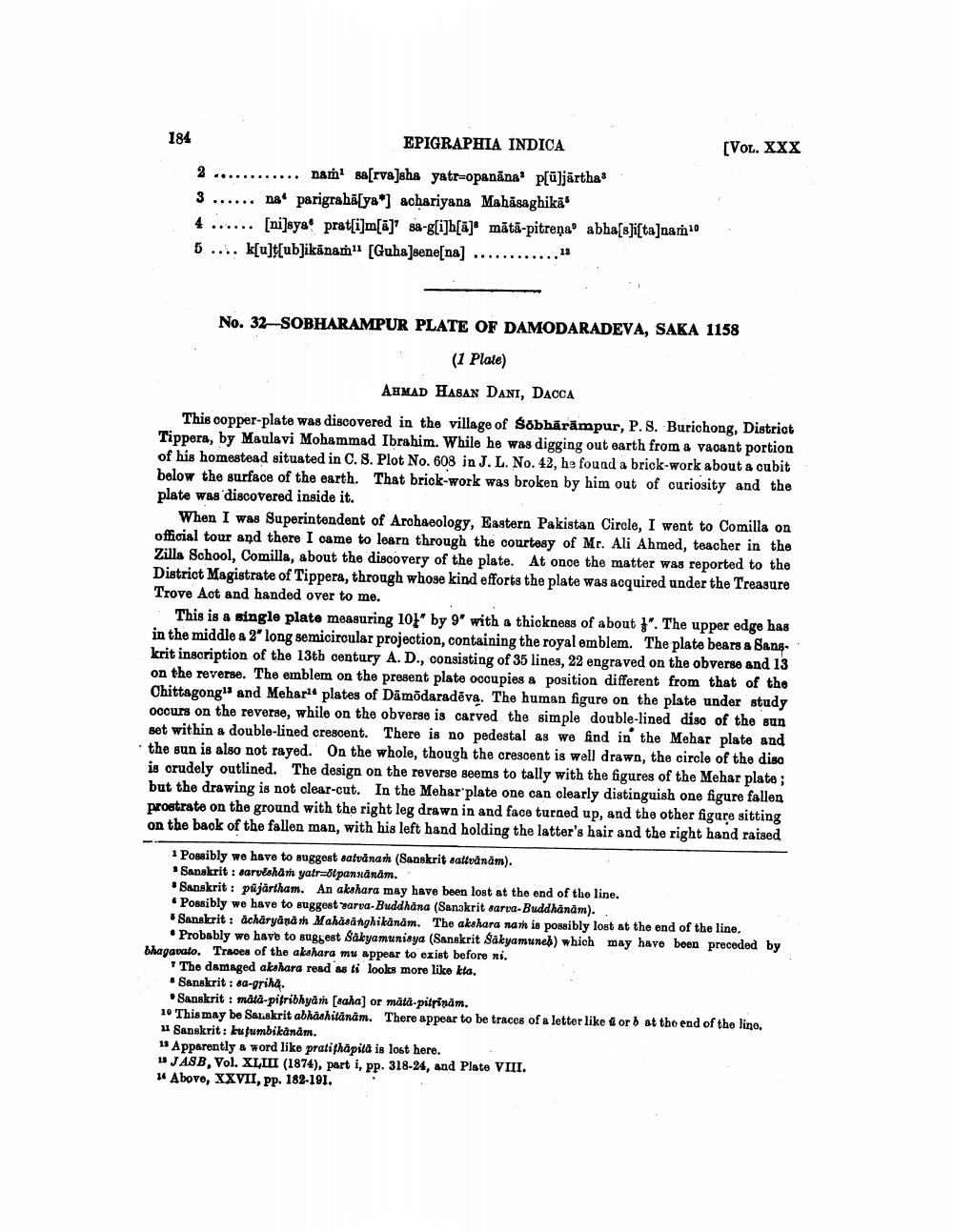________________
184
EPIGRAPHIA INDICA
(VOL. XXX
............ nam sa[rva]sha yatr-opanana' p[ūjārtha 3 ...... na parigrahā[ya*) achariyana Mahāsagbikā 4 ...... [ni]sya prat[i]m[á]’ sa-g[i]b[@]* mātā-pitreņa" abha[]i[ta]nam 5... k[u]t[ubjikānam" [Guha]sene[na] ............"
No. 32-SOBHARAMPUR PLATE OF DAMODARADEVA, SAKA 1158
(1 Plate)
AHMAD HASAN DANI, DACCA This oopper-plate was discovered in the village of Sobhärāmpur, P. S. Burichong, District Tippera, by Maulavi Mohammad Ibrahim. While he was digging out earth from a vacant portion of his homestead situated in C. S. Plot No. 608 in J.L. No. 42, he found a brick-work about a cubit below the surface of the earth. That brick-work was broken by him out of curiosity and the plate was discovered inside it.
When I was Superintendent of Archaeology, Eastern Pakistan Circle, I went to Comilla on official tour and there I came to learn through the courtesy of Mr. Ali Ahmed, teacher in the Zilla School, Comilla, about the discovery of the plate. At once the matter was reported to the District Magistrate of Tippera, through whose kind efforts the plate was acquired under the Treasure Trove Act and handed over to me.
This is a single plate measuring 101" by 9" with a thickness of about 3". The upper edge has in the middle a 2' long semicircular projection, containing the royal emblem. The plate bears & Sanskrit inscription of the 13th century A. D., consisting of 35 lines, 22 engraved on the obverse and 13 on the reverse. The emblem on the present plate occupies a position different from that of the Chittagong and Meharli plates of Damodaradēva. The human figure on the plate under study occurs on the reverse, while on the obverse is carved the simple double-lined disc of the sun set within a double-lined crescent. There is no pedestal as we find in the Mehar plate and the sun is also not rayed. On the whole, though the crescent is well drawn, the circle of the disa is crudely outlined. The design on the reverse seems to tally with the figures of the Mehar plate; but the drawing is not clear-cut. In the Mehar' plate one can clearly distinguish one figure fallen prostrate on the ground with the right leg drawn in and face turned up, and the other figure sitting on the back of the fallen man, with his left hand holding the latter's hair and the right hand raised
1 Possibly we have to suggest satvanas (Sanskrit sattvanām).
Sanskrit : sarvesham yatratpannānam." Sanskrit: püjärtham. An akahara may have been lost at the end of the line. • Possibly we have to suggest arva-Buddhana (Sanskrit sarva-Buddhanam).
Sanskrit: acharyanath Mahasanghikanām. The akshara nam is possibly lost at the end of the line.
• Probably we have to suggest Sakyamuniaya (Sanskrit Sakyamuneb) which may have been preceded by bhagavato. Traces of the akshara mu appear to exist before ni.
* The damaged akshara read as ti looks more like kta. • Sanskrit: 8a-griha.
Sanskrit : mätā-pifribhyam [aaha) or mäta-pitrinam. 10 This may be Sanskrit abhashitanam. There appear to be traces of a letter like orb at the end of the line. 11 Sanskrit: kufumbikanām. 14 Apparently a word like pratiphäpila is lost here. 13 JASB, Vol. XLIII (1874), part i, pp. 318-24, and Plate VIII. 14 Above, XXVII, pp. 182-191.




